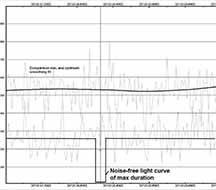


This is a quite do-able event, with MIRA Observatory inside the predicted path. I plan to have Kirk on the 14" PlaneWave Scope at the MIRA Observatory, and I will try it from nearby Fire Lookout peak. Dan will help us and graciously allowing us to use the Observatory while/around the time he is doing polarimetry.
The charts below are alt/az for the 8SE scopes, as usual (and for me). The alt-az scope 14" should not be too different in orientation since the azimuth is 155, only 25 degrees away from due south when they should be in alignment with the alt/az chart.
 |
 |
 |
We were lucky to be able to get time on the Big Scope at MIRA. With the brightness of the stars, and with the polarimeter of Dan Cotten on the 36" scope, the 14" Planewave SCT scope was going to be the best instrument to get this event. The target star was bright enough that we'd be able to do field-mode astrometry, with 1/60 second time resolution. It was going to be difficult to get tree-free skies within the path, in this rugged high altitude country. The best choice was to use the old fire lookout on the high peak of Chews Ridge, at 5,000 ft, and about 3/4 of a mile north of the MIRA instrument. Given the narrow path, this would still provide good spatial resolution, and close enough to help verify a positive with both sites. Kirk's NTSC Watec gave better time resolution, and logistics said he was the logical choice to b on the Planewave scope, and I brought the 8SE scope to get it from the fire lookout.
We were also lucky with the clouds - the fog was deep and heavy, but only came up to an altitude of about 3,000 ft, far below our 5,000 ft observatory. A bright 84% moon was still in the sky to brighten things, but no cirrus or other clouds. However, we did have a breeze which stiffened into a significant ~30mph wind. Kirk was protected from the wind at the MIRA scope, but I had to contend with it more seriously at the fire lookout.
The wind was difficult, but not fatal for me at the fire lookout. There was a small lightening protection cage made for the lookout personnel to retreat into during a lightening storm, and this was about 6 ft wide; just barely wide enough to give wind shelter for my 8SE scope if I tucked myself close up against it. The direction to the target star was ~due south, and the wind was straight out of the west. It worked, and I got good data. However, I worried and so I use 4x as my integration setting, to help with S/N. The data give high odds of a miss, and Kirk's miss at MIRA across the ridge made it a high confidence conclusion.
I used the HighPoint metal longer nosepiece, and discovered that at maximum insertion it makes for a smaller FOV and perhaps affects the focus as well. One nice aspect is that in a hurry, I can find where the par-focal point is so that the stars are in focus whether in the Q70 or in the Watec w/o changing the focus knob on the Celestron, and just lock it into place and swap back and forth quicker between Q70 and Watec if I'm having trouble ID'ing the field.
|
PyMovie screen capture, with the dynamic aperture for the target star. See the histogram of pixel values at far right of the sky image, and note that the bottom of the Gaussian distribution of blank sky is clipped, for reasons still not understood by the occultation community. It artificially raises the bottom of a full depth occultation by a bit, but otherwise does not affect the timings. |
Composite light curves; for the Ref1, Ref2, Target (in gold), and blank sky (no-star, in red) |
Target star light curve, and the changing pixels size of the dynamic mask (below). I chose a minimal 11 pixel box to avoid having the software shift to a nearby fainter star |
The blank sky (No-star labelled). Note the average of the counts is not at zero, because the software assumes a Gaussian distribution for the histogram of the pixel values. |
I combined the 2-frames per integration to yield the PyOTE light curve. I chose the metric interval to be all values after the predicted occultation, and then raised the smoothing length on the comparison star until the metric value was minimized. I further minimized it in case of slight haze offset, by changing the horizontal offset (time). Minimum dispersion was for about 1 second offset between comparison and target, and not much changed.
|
 |
Kirk Bender
Kirk set up on the 14" planewave. I gave him my mid-size nosepiece so he could use the 0.5x reducer to help concentrate the light. The f/3.3 reducer we ususally use, of course, cannot be used on anything but a Celestron or Meade SCT telescope.